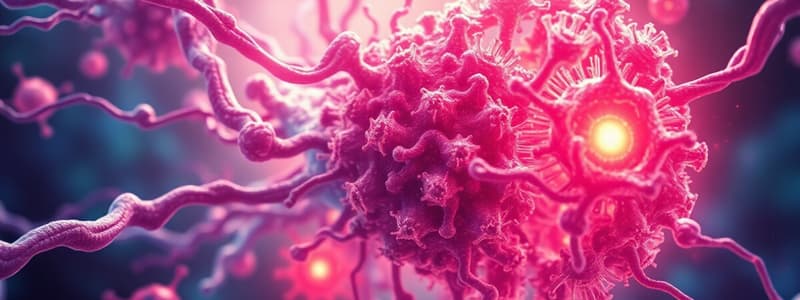Podcast
Questions and Answers
What is the primary role of pharmacodynamics in drug therapy?
What is the primary role of pharmacodynamics in drug therapy?
- It analyzes the absorption and distribution of drugs.
- It describes how the body metabolizes drugs.
- It explains the mechanisms of drug action on the body. (correct)
- It focuses on the interactions between drugs and enzymes.
What type of ligand fully activates a receptor, resulting in a pharmacologic effect?
What type of ligand fully activates a receptor, resulting in a pharmacologic effect?
- Non-competitive antagonist
- Partial agonist
- Full agonist (correct)
- Inverse agonist
Which of the following describes a partial agonist?
Which of the following describes a partial agonist?
- It blocks the receptor entirely.
- It has higher affinity than a full agonist.
- It has no effect on the receptor.
- It activates the receptor with lower efficacy compared to a full agonist. (correct)
How do competitive antagonists affect agonist potency?
How do competitive antagonists affect agonist potency?
What distinguishes non-competitive antagonists from competitive antagonists?
What distinguishes non-competitive antagonists from competitive antagonists?
What is the main characteristic of an agonist in pharmacology?
What is the main characteristic of an agonist in pharmacology?
Which parameter is used to measure the efficacy of a drug from the graded dose response curve?
Which parameter is used to measure the efficacy of a drug from the graded dose response curve?
How does a competitive antagonist affect the dose-response relationship of an agonist?
How does a competitive antagonist affect the dose-response relationship of an agonist?
In non-competitive antagonism, what effect does the antagonist have on the Emax of the dose response curve?
In non-competitive antagonism, what effect does the antagonist have on the Emax of the dose response curve?
What does EC50 represent in the context of potency in pharmacology?
What does EC50 represent in the context of potency in pharmacology?
Flashcards are hidden until you start studying
Study Notes
Pharmacodynamics: What the Drug Does to the Body
- Pharmacodynamics is the study of what drugs do to the body; it's essentially how drugs work at a cellular and molecular level.
- Four processes are involved in drug therapy:
- Pharmacokinetics: What the body does to the drug
- Pharmacodynamics: What the drug does to the body
Mechanisms of Drug Action
- Receptor-mediated drug action: Many drugs work by binding to specific receptors located on cell surfaces.
- Receptors are cellular macromolecules, often proteins, that interact with ligands.
- Ligands are chemical substances that bind to receptors.
- Drugs can act as:
- Agonists: Ligands that bind to receptors and activate them, leading to a cellular response
- Antagonists: Ligands that bind to receptors but block the activation process, preventing a cellular response
Full Agonist
- A full agonist has both affinity, meaning it binds to the receptor, and efficacy, meaning it activates the receptor to produce a maximal response.
- The higher the efficacy, the stronger the effect.
Partial Agonist
- A partial agonist has affinity but only partial efficacy; it binds to receptors but activates them with less "power" than a full agonist.
- In the presence of a full agonist, it can act as an antagonist, competing for the same receptor.
Antagonist
- Antagonists possess affinity for the receptor but lack efficacy; they bind but do not activate the receptor.
- They block the effects of agonists by preventing them from binding.
Types of Antagonists
- Competitive antagonists compete with agonists for the same binding site on the receptor.
- This reduces the potency of the agonist, but the maximal effect can still be reached with higher doses.
- Non-competitive antagonists bind to a different site on the receptor or prevent the agonist from activating the receptor.
- This reduces the maximal effect, even with higher agonist doses.
Dose-Response Curves
- Graded dose-response curves depict the relationship between the dose of a drug and the magnitude of the response.
- The curve is plotted with the dose of the drug on the x-axis (logarithmic scale) and the response on the y-axis.
- This helps understand how the intensity of the drug's effect changes with different doses.
Interpreting Graded Dose-Response Curves
- Efficacy: The maximum effect a drug can produce.
- Emax represents the maximum response on the curve.
- Higher Emax indicates greater efficacy.
- Potency: The dose required to produce a specific effect (typically 50% of the maximum effect).
- EC50 is the dose that produces half the maximum response (Emax).
- A lower EC50 value means greater potency.
Competitive Antagonism
- Competitive antagonists shift the dose-response curve to the right, increasing the EC50.
- The maximal effect (Emax) remains unchanged, though higher doses of the agonist are needed to reach it.
- This process is similar to two people trying to occupy the same seat; the person with the stronger claim will likely win.
Non-Competitive Antagonism
- Non-competitive antagonists shift the dose-response curve downwards, reducing the Emax.
- This is because they hinder the agonist's ability to produce a maximal effect by altering the receptor's activity or preventing binding.
All-or-None Dose-Response Curves
- These curves show the percentage of subjects who respond to a drug at different doses.
- ED50 (Effective Dose 50): The dose required to produce a therapeutic effect in 50% of the subjects.
- Lower ED50 means greater potency.
- TD50 (Toxic Dose 50) or LD50(Lethal Dose 50): The dose that produces toxicity in 50% of the subjects.
- Lower TD50 or LD50 indicates greater toxicity.
Therapeutic Index
- Therapeutic Index (TI) is a measure of drug safety, expressed as the ratio of the TD50 to the ED50.
- A higher TI means a wider range between the effective dose and the toxic dose, indicating a safer drug.
- A lower TI signifies a narrower margin, making the drug potentially more dangerous.
Therapeutic Window
- The range between the minimum effective dose and the minimum toxic dose is called the therapeutic window.
- Drugs with a narrow therapeutic window require careful dose titration to minimize toxicity.
- Examples include anticoagulants, antiepileptics, and lithium.
- These drugs require careful monitoring and dose adjustments.
Signal Transduction Systems
- Signal transduction systems are cellular pathways that allow cells to respond to external stimuli, such as drug molecules.
- These systems involve a chain of events triggered by the binding of a drug to a receptor, culminating in a cellular response.
Types of Receptors
- Ion Channels: These receptors are ion-selective channels in the cell membrane. Agonist binding opens the channel, altering membrane potential or intracellular ion concentration, leading to changes in cell activity.
- Example: Nicotinic acetylcholine receptors
- G Protein-Coupled Receptors (GPCRs): These receptors are linked to G proteins, which are trimeric proteins (α, β, and γ subunits).
- Agonist binding activates the G protein, leading to the release of the α subunit that regulates various cellular processes.
- Receptors Linked to Tyrosine Kinase: These receptors have both an extracellular and an intracellular domain.
- Binding of the agonist to the extracellular domain activates the intracellular tyrosine kinase enzyme, leading to phosphorylation of proteins and subsequent cellular responses.
- Receptors Regulating Gene Transcription: These receptors are found in the cytoplasm or nucleus.
- Binding of the agonist to these receptors triggers the movement of the activated receptor to the nucleus where it interacts with DNA, regulating gene expression and ultimately protein synthesis.
Receptor Cycling or Turnover
- Receptors are constantly being synthesized, internalized, and recycled by the cell.
- Down-regulation: Continuous exposure to an agonist can lead to a decrease in the number of receptors, making the cells less sensitive to the agonist.
- Up-regulation: Continuous exposure to an antagonist can lead to an increase in the number of receptors, making the cells more sensitive to the agonist.
Non-Receptor Mediated Drug Action
- Drugs Acting on Enzymes: These drugs can inhibit or activate enzyme systems, altering enzymatic activity.
- Example: Aspirin inhibits cyclooxygenase, reducing prostaglandin synthesis.
- Drugs Acting on Plasma Membranes: These drugs can alter the permeability, carrier systems, transport processes, or enzyme systems within the plasma membrane.
- Example: Polyene antifungal drugs increase the permeability of fungal plasma membranes.
- Drugs Acting on Subcellular Structures: These drugs can target structures like mitochondria or microtubules.
- Drugs Acting on the Genetic Apparatus: These drugs can interfere with DNA synthesis or function.
- Example: Antibiotics inhibit bacterial protein synthesis.
- Drugs Acting by Chemical Action/Antagonism: These drugs act by directly interacting with the agonist or neutralizing it.
- Example: Antacids neutralize hydrochloric acid in the stomach.
- Physiological Antagonists: These drugs work on different receptors to produce opposite effects, counteracting each other.
- Example: Epinephrine and histamine in anaphylactic shock
Studying That Suits You
Use AI to generate personalized quizzes and flashcards to suit your learning preferences.




